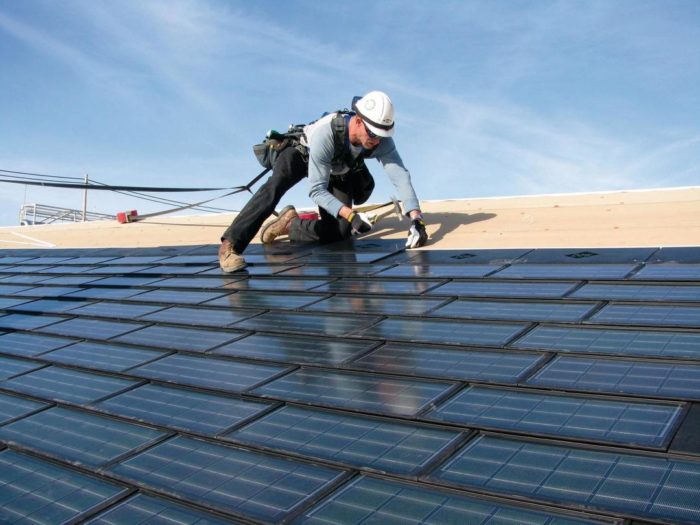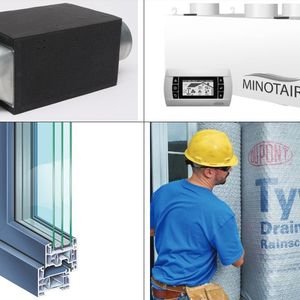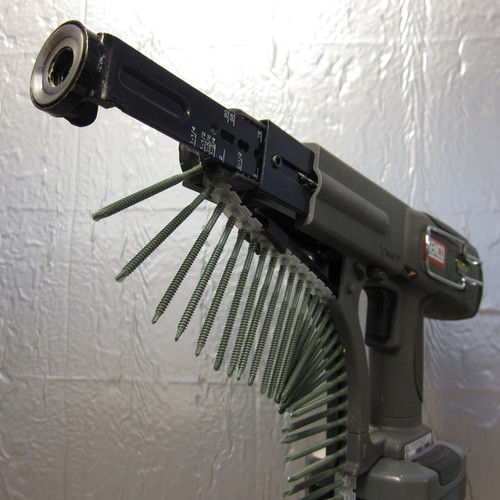
Image Credit: Dow
My folder of interesting new building products is getting thick, so it’s time for another new product roundup. I’ll review three brands of photovoltaic roofing designed to integrate with asphalt shingle roofs. I’ll also discuss several new types of insulation: a new type of rigid foam, batts made from plastic fibers, and batts made from hemp.
I recently discovered two manufacturers with similar names: one in Maine (Wasco Skylights) that makes high-performance triple-glazed skylights, and another in Wisconsin (Wasco Windows) that makes high-performance triple-glazed windows. Finally, I’ll describe a handy device for energy raters who perform duct leakage tests.
Powerhouse PV Shingles from Dow
Dow Building Solutions is selling thin-film photovoltaic (PV) modules designed to be integrated with an asphalt shingle roof. Called Powerhouse Solar Shingles, the PV modules use thin-film (copper indium gallium selenide) cells made by Global Solar. Because the PV shingles don’t have to be mounted on an aluminum rack that sits on top of the roofing — the Powerhouse shingles are roofing — the resulting PV array is inconspicuous.
The shingles must be hand-nailed by installers who have been trained by Dow; no nail guns are allowed. Each shingle is designed to plug into the adjacent shingle, minimizing wiring connections. All wiring penetrations are covered by the shingles.
For now, Powerhouse shingles are only available in Colorado; Dow hopes to expand the geographical reach of its distribution network in the future. Although Dow hasn’t released pricing information, it’s safe to say that these shingles are less efficient and more expensive than conventional PV modules. The efficiency of Powerhouse shingles is only 12%, while conventional crystalline PV modules have efficiencies of 18% or more. That’s why Powerhouse shingles need a larger area for the same electrical output as a comparable array of conventional PV…
Weekly Newsletter
Get building science and energy efficiency advice, plus special offers, in your inbox.

This article is only available to GBA Prime Members
Sign up for a free trial and get instant access to this article as well as GBA’s complete library of premium articles and construction details.
Start Free TrialAlready a member? Log in















16 Comments
BIPV
I don't understand the big deal with traditional roof-mounted solar modules. When properly designed and installed, they look just fine. The BIPV shingle seems like more trouble than its worth. Firstly, thin film is more inefficient than mono or polycrystalline--avg of 10-13% thin film efficiency vs 16-22% for the others. Next is cost, both in material and labor. Each shingle has 2 wires which need to be plugged in series and then parallel. Times that by a thousand or two and you've got labor costs to pretty up that attic ceiling. Don't forget about the cost of the product. At $5-7 per watt, that's between 2-3 times the cost of a traditional module. Finally, I'd be concerned about performance. Traditional roof mounted modules are (or should be) 4 inches above the roof, providing necessary airflow underneath the modules, which helps with the production numbers and also helps to ensure higher cell efficiency over the lifetime of the module. I understand that thin film can take the heat better than silicon, so I don't know how critical airflow is for thin film--just something to consider.
What about servicing and warranty? I would bet that the mandatory warranty of 5 yrs on this system costs the owner of the system more. What happens if there is a ground fault dead smack in the middle of the roof? With voltages of only 3-6 vs 200 per module, it can be harder to find the problem module during troubleshooting.
In conclusion, I don't see the true benefit of these BIPV shingles. If a traditional rooftop array bothered me that much, traditional modules can be incorporated as the roof as well. In fact, this is widespread in Germany.
Response to Deniz Bilge
Deniz,
I agree with all of your points.
Roofing is roofing; a PV array is a PV array.
My vote: keep them separate.
Wasco Skylights
Despite being in Maine, I only became aware of their skylights in the past couple of years myself.. Ive installed one and was impressed with the quality, performance and price.
reply to Deniz and Martin
I too agree. the "shingles" however may be a manageable way to get around building covenants in some areas. The prez of a local HOA, when I was considering a remodel in the S/D, thought solar shingles might be accepted under the current rules and not require a special waiver etc.
Personally, I'd rather prep the conduit etc in the attic and then get on the board of the HOA and lobby from strength for what will work better. (i.e., panels)
InsulFoam
When I was 13, I went to California for the first time. I saw a house getting built and noticed styrofoam dust on the ground by the exterior wall under construction. I knew nothing about construction and thought that they were crazy for building a house out of styrofoam. Almost 25 years later, it's actually starting to happen. What's next, building a house like a surfboard??--foam shell encased within a fiberglass or epoxy protective coating? Should NASA get into airtight home construction that includes air pressure regulators? Where's this industry headed?
Back to the Insulfoam... haven't seen this stuff, but 2 questions: How is this stuff secured to withstand 115mph? Does it have any shear strength like plywood? Another thing I believe is that extra fire resistance measures should be incorporated into the product, like a cement-based backer or something of similar value. This whole foam idea is pure poison if that roof catches fire.
Probably more expensive than slate...the Industry needs to get back to the supply-demand curve. Everything's so cost prohibitive anymore for no good reason. I'm convinced that things cost what they do simply because they can away with it, not because of supply/demand. I'm sure a couple extra bucks can be spent to protect the foam from fire and still rake in the profit, without increasing the price of the product.
forgot something in comment 1
I forgot to comment on the photo of the guy installing the PV shingles on the plywood...It looks to me like those wires will be sitting between the unprotected plywood and the shingles, which spells lots of heat with no cooling airflow to me. Electrically, this means the temperature correction factor for determining the PV wire sizes could potentially be great enough that code may require a #8 or larger wire size. Although I never actually held one of these shingles, I'm willing to bet that #10 AWG is what the factory seals in the junction box.
To remedy the situation, if this shingle were to be installed, I would use lath boards across the rafters and no plywood (as in the old cedar roof installations), or somehow else make sure there is airflow or insulation or both between the plywood and shingle.
Insulfoam questions
Deniz,
Q. "Does it [Insulfoam] have any shear strength like plywood?"
A. No. Insulfoam is insulation, not roof sheathing. It is installed on top of the roof sheathing, usually on a low-slope (flat) commercial roof. This is the most common way of insulating low-slope roofs. Tens of thousands of buildings are insulated this way, all over the country.
Q. "How is this stuff secured to withstand 115 mph [winds]? "
A. With cap screws.
Q. "Probably more expensive than slate."
A. No, it is far cheaper than slate. But slate is roofing; this is insulation. Even if you found a way to install slate on a low-slope roof, you would still need insulation.
I didn't realize the
I didn't realize the insulfoam is installed in conjunction with sheathing or recovery board...thought it was some miracle by itself system....
Just wondering what the experts here think (while we're in a blog about building products) about magnesium oxide boards as replacement for both drywall and cement board---mold resistant, easier to work with than cement board, unaffected by water saturation due to its ability to dry out and resist mold (the magnesium content), inert (no silica or poisonous chemicals), easy installation (not necessary for joints to land on studs, brad nails & adhesive)...But what about the cons?
I've heard that they corrode metal (nails and studs) due to a chemical reaction that occurs when the material gets wet..something to do with magnesium chloride...Wondering if anyoyne knows the myth from fact here...
vent cap systems
Martin ... I ordered a few to see how they worked ... they are useless at rough-in (no ceiling in place) and they can't be secured tight enough to guarantee no leakage even at +25pa ... they are held in place by line friction, which is not enough ... camera & smoke stick verify leakage ... covers on an adjustable pole, either manufactured or self-made, are more reliable ... we started with tupperware containers, applied self-adhesive weatherstrip to the outside edges, glued drywall sanding pole swivels underneath and inserted adjustable poles ... same procedure only with plywood instead of tupperware, at rough-in. Works great at fraction of cost ... a bit more cumbersome but reliable.
Response to Paul McGovern
Paul,
Thanks for you very valuable comments. A great tip.
thin laminate PV on standing seam metal roof
Certainteeds product looks like it's for asphalt shingles, but I learned about thin PV laminate when i saw it applied to a standing seam metal roof. Is this the same product mentioned here?
Response to Steven O'Neil
The products mentioned in this article are designed for asphalt shingle roofs.
You are thinking of a different product from Uni-Solar. Their peel-and-stick product for metal roofing is now called Uni-Solar PowerBond. (It has been sold in the past under a variety of names).
Here is a link to more info: http://www.uni-solar.com/wp-content/uploads/2011/11/PB_ePVL_Technical_Data_Sheet_EN_%28AA6-3624-04%29.pdf
Thin Film Vs. Crystalline
I am no expert and these are as much questions as anything but here goes:
Production under similar high temperature conditions. Thin film do not have nearly as great an efficiency drop off as crystalline. So if you have a large area on the roof in Arizona it may be worth your while to go for Thin Film.
Similar in climates like the intermountain west, say Utah, where seismic snow and high summer temperatures play a role thin films can beat out crystalline due to weight, bearing capacity and temperature. That is not to say that all of those factors cannot be accounted for in Crystalline, they can and are but that from a whole product, install and climate standpoint a thin film may be a wiser choice.
I have heard than thin films perform better under low light conditions, not sure this accurate or not. If not should be included in one of Martyn's "myths" (caveat not truly myths) columns.
Perhaps the greatest reason to go with thin films, and admittedly the least nerdy, is that many HOAs and design review committee, justified or not, have less of an issue with them.
PV Shingles
Personally, I've been waiting for these for a long time, and as costs come down, I think they will be quite successful. I can't stand bolt on PV panels. It pains me to see ugly junk slapped on to the outside of a building. There is a zero energy townhouse project near me called the Z-Homes, these townhouses are beautifully planned and designed, but then they slapped bolt on PV panels to the roofs and it made me sad. PV shingles would have really made this project, but unfortunately, green design is still ugly in some ways. PV shingles are an intentional and beautifully incorporated product that I wish all the best for.
There are valid issues with PV shingles. I just hope the manufacturer and installers are addressing some of the issues. All PV panels or arrays should be independent from one another, monitored by the user, and accessible for maintenance and repair. If these, a decent warranty, and a cost effective solution can be achieved, then PV shingles will be a highly successful product, and something that I will personally invest in and recommend. Regardless, how can you say no to such a beautiful, intentional, integrated PV product?
Grace Ice & Water over Insulfoam
Maryland, mixed humid, 4A.
I read that I could use fully adhered membrane over the Insulfoam polyisocyanurate layer. Could one place Insulfoam on the walls to the exterior of the sheathing and then lap Grace Ice and Water exterior to that as an air barrier? Like a reverse PERSIST/REMOTE?
Do you know if Grace Ice and Water would keep the termites from the rigid foam?
Would the membrane still work as an air barrier if the foam shrinks in the future?
Response to Richard Ugarte
Richard,
There are many roofing manufacturers that sell membrane roofing. Products include EPDM roofing and PVC roofing. These roofing products can be installed on the exterior side of InsulFoam HD Composite, as long as the foam manufacturer tells you that they are compatible.
Grace Ice & Water Shield is not roofing; it is a rubberized asphalt membrane that must be protected from UV exposure by a layer of roofing that goes on top of the Grace Ice & Water Shield.
There is no need for two layers of membrane. As long as you plan to install a membrane on top of the foam, choose a roofing product, not Ice & Water Shield.
Log in or become a member to post a comment.
Sign up Log in